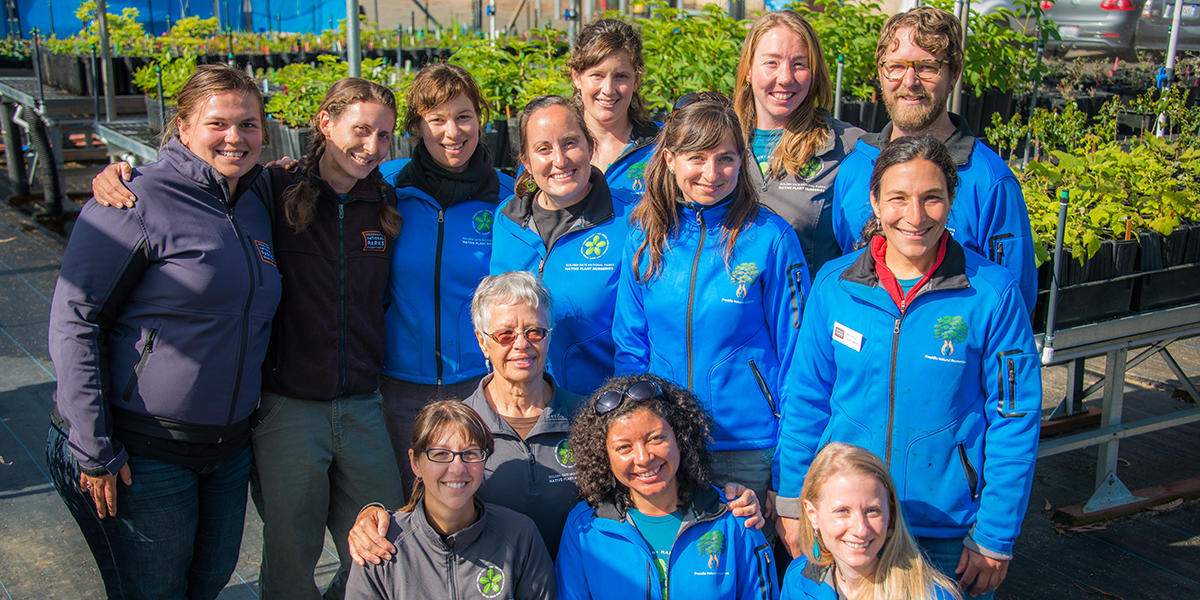Your parks need you now
Your support helps fight climate change and promote park sustainability—please give now.

Retiring as director of our Native Plant Nurseries gives me an excuse to think about how far the nurseries have come. When I arrived in the Golden Gate National Parks in 1997, there were already habitat restoration efforts in place—but park plant ecologists were realizing that the need for planting was much greater than what could be grown.
Having already worked in the propagation of native plants for restoration projects throughout northern California, I had hopes for a more holistic and encompassing restoration of parklands at Golden Gate. I shared a restoration vision that included a great diversity of plants, providing all the threads that together create that unique web of life—and supporting hundreds of insects, rodents, birds and raptors, and those charismatic larger mammals.
Now, as I reflect on my time here in the park, I know that purpose has come a long way towards fulfillment. From Muir Beach to Mori Point, from Hawk Hill to Crissy Field, and all across the Presidio, restoration efforts by the Parks Conservancy, National Park Service, and Presidio Trust have benefited a wide range of wildlife—including rare, threatened, or endangered species. The California red-legged frog, San Francisco garter snake, mission blue butterfly, coho salmon, Franciscan manzanita, and many more species now enjoy expanded and healthier habitat—due in large part to the palette of plants that are thriving in restored landscapes.
None of these restoration projects would function so well without high-quality plants from our nurseries. But to grow the best possible plants, we had to improve our facilities. At the outset, some greenhouses were made of irrigation piping and plastic sheeting; other buildings were made of reused wood that soon began to rot. High temperatures in these structures unfortunately “cooked” a lot of young plants. So, over the years, each of our nurseries underwent major renovations, adding commercial-grade greenhouses and shadehouses, enhancing storage and potting-up areas, improving amenities for staff and volunteers, and upgrading our computers to track and analyze best practices on how to grow native species.
When I started, when we had no organized nursery program, little was known about the 650 native types of plants found in the Golden Gate National Parks. Since then, we have learned to grow over 400 species of plants that are native to the park (I hardly know 400 people!).
This entails understanding when each species of seed ripens—and what natural processes that seed undergoes in the wild to induce germination—so we can imitate those processes in the nursery. That may require sanding a seed to imitate passage through a bird, or putting seed in boiling water, warm water, or liquid smoke, or actually burning it—to imitate natural fire. Then cold moist or warm and cold treatments must be given to most species. After planting, we have to determine optimal pot size, ideal amounts of water and fertilizer, and the perfect pruning method—and each species is different! Our experience and trials have produced propagation protocols for almost 450 species, and that information is now available in our nursery database and soon to be online.
In all, since 1997, we have grown over 2 million plants.
I think back on the more than 7,000 volunteers who have helped us reach that milestone, and particularly the 100 or so dedicated stalwarts whom we can count on every week. They are our foundation. I think of how nursery staff have introduced over 30,000 students to the park, enhancing their knowledge of ecosystems and showing them how they can take part in the restoration of this park for all forever. And I think of how there is still much to learn.
Fortunately, we also have passed on our accumulated knowledge and experience to almost 100 interns in the nurseries—many of whom are now growing plants for restoration throughout the United States. To help transition recent college grads into professionals, we have written “The Science and Art of Growing Plants for Habitat Restoration.” And, even more importantly, our intern training program has evolved into Park Academy, giving park volunteers, interns, and Parks Conservancy members a deeper understanding of the importance of the work we do and why we do it.
It has been my honor and privilege to serve the Golden Gate National Parks, to work for the amazing Parks Conservancy, and to support our wonderful nursery volunteers and particularly the nursery staff—Clara, Chelsea, Liz, Annette, Alisa, Brianna, Ely, Michele, and Meghan. You have made it all happen. And now under the leadership of Alisa Shor, you will continue to excel and move forward.
Looking back, we all—staff, volunteers, and members—can be proud of what we have done. The true seed of successful long-term stewardship begins—and always will begin—with you.
By Betty Young
Director, Native Plant Nurseries (1997–2014)
Your support helps fight climate change and promote park sustainability—please give now.